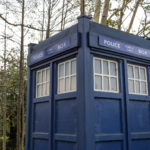 There’s a house nearby that has a TARDIS in the back garden. Have you ever wished you had a time machine? We could have used one last weekend as we traveled back into the past. Our move date looms on the horizon, and I am trying to gather as much information on the Celts as possible before we go. Archaeologists have found many ancient Celtic sites in the area, and I hope to learn more about the daily lives of these people. While some are nearby, many are within a 3-4 hour drive.
There’s a house nearby that has a TARDIS in the back garden. Have you ever wished you had a time machine? We could have used one last weekend as we traveled back into the past. Our move date looms on the horizon, and I am trying to gather as much information on the Celts as possible before we go. Archaeologists have found many ancient Celtic sites in the area, and I hope to learn more about the daily lives of these people. While some are nearby, many are within a 3-4 hour drive.
I’ve been to two museums and two reconstructed sites in Austria, which blew me away. So, when I heard about a city with a population of 5,000, I had to see it. It is considered one of the wealthiest towns in the Celtic world and claims to be ‘the oldest city north of the Alps.’ On Friday, we drove to Heuneburg.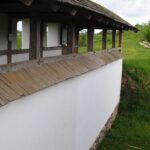
In the 5th century BCE, the Greek historian Herodotus wrote of a great city, saying, “For the Ister flows from the land of the Celts and the city of Pyrene through the very middle of Europe…” The Ister refers to the Donau or the Danube River. And archaeologists have located an important trade center at the right location, so it is accepted that the town on the bluff was the city the Greeks called Pyrene.
Heuneburg, or Pyrene, began as a pre-historic hill fort in what is now southern Germany. The plateau measures 300 x 150 meters (980 x 490 feet), comprising roughly five acres. Its location above the Danube most likely accounts for its growth into a key trading center. Evidence has been found for luxury goods, wine, and amber from the south and leather and fur from the north. Workshops creating bronze items and highly decorated local pottery for trade have been discovered.
 From 700 BCE on, the plateau was fortified. Initially, the city followed the typical Celtic plan of a ditch and bank enclosure surrounding houses of wood and daub construction. Over time, the town underwent many changes, and as many as twelve distinct periods have been identified. The most spectacular feature was the mud-brick wall constructed around 600 BCE, and replacing the wooden barricade on top of the ramparts. It is believed to have been adapted from Mediterranean designs. The new fortification consisted of a limestone base with a four-meter-high wall of bricks made of sun-dried clay. These were covered with white lime plaster to prevent the unbaked bricks from eroding in the northern climate. This was surmounted by a covered walkway with towers evenly spaced along it. That must have been quite a sight. And it lasted much longer than the old walls without needing to be replaced every few years.
From 700 BCE on, the plateau was fortified. Initially, the city followed the typical Celtic plan of a ditch and bank enclosure surrounding houses of wood and daub construction. Over time, the town underwent many changes, and as many as twelve distinct periods have been identified. The most spectacular feature was the mud-brick wall constructed around 600 BCE, and replacing the wooden barricade on top of the ramparts. It is believed to have been adapted from Mediterranean designs. The new fortification consisted of a limestone base with a four-meter-high wall of bricks made of sun-dried clay. These were covered with white lime plaster to prevent the unbaked bricks from eroding in the northern climate. This was surmounted by a covered walkway with towers evenly spaced along it. That must have been quite a sight. And it lasted much longer than the old walls without needing to be replaced every few years.
While there is evidence of Bronze Age occupation, the heyday of the site was from the 7th-5th centuries BCE. While people continued to live on the site into medieval times, it seems never to have recovered its former glory after a fire devastated the town in the 5th century BCE.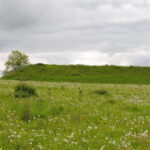
I must admit, though, I was a bit underwhelmed by our visit. To be fair, the five buildings on the site were closed due to roof renovations. The recreated corner of the wall is impressive, and the earthen ramparts still exist. Even so, I felt the exhibits at the Durrnberg and Keltendorf Mitterkirchen in Austria provided more information, as did the museums in Hallstadt and Hallein. While in the area, we did tour the Heuneburg Museum. Some of the finds were on display there, though none of it was in English, so I have a  lot to translate to learn more about the people who lived there.
lot to translate to learn more about the people who lived there.
We decided it would be worthwhile to see the artifacts from the grave of the Hochdorf Prince in their museum, which was very interesting. And on that site, they have reconstructed a farm found in the local area. How cool!
But this post is about time travel. And as Dave and I usually do, there were side trips. On our way to Hochdorf, we passed the town of Bad Urach. It looked like an excellent place to explore. After visiting the museum, lunch was next on our agenda, so we returned to Bad Urach. Nothing like leaping 1,000 years into the “future.” The buildings in the alt stadt, or old town, date from the 15th century. From 400 BC to 1400 AC in less than two hours.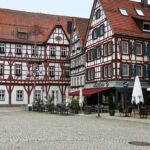
Occupation on this site dates to the Stone Age based on findings in the caves above the current town. Hohenurach Castle was built in 1025 on the hill overlooking the Erms Valley. By 1260, the city prospered as a weaving center known as Urach. Today, the town is a spa town and has added the name Bad (bath/spa) to its name. Millions of years ago, volcanic activity created a thermal spring with a constant water temperature of 61° C (or 141° F). But we were there for the old town and explored the medieval marketplace. The architecture was stunning.
 While it was time to head home, there was another stop to be made. On the autobahn was a sign for a UNESCO World Heritage Site: Roman Limes. Of course, we stopped. The word Limes refers to the line the Romans drew across Europe as they conquered it. Pronounced lee-mes, it is the root of the modern word limit. It was a line of forts marking the extent of the Roman Empire. It stretched from the Black Sea in Eastern Europe to the North Sea, along The Netherlands. In Britain, it was the line between the land of the Scots and the rest of the island.
While it was time to head home, there was another stop to be made. On the autobahn was a sign for a UNESCO World Heritage Site: Roman Limes. Of course, we stopped. The word Limes refers to the line the Romans drew across Europe as they conquered it. Pronounced lee-mes, it is the root of the modern word limit. It was a line of forts marking the extent of the Roman Empire. It stretched from the Black Sea in Eastern Europe to the North Sea, along The Netherlands. In Britain, it was the line between the land of the Scots and the rest of the island.
We have come across many of the forts on our outings. Often on hiking trips, we have seen signs marking the old lines of the Limes. Now, heading back to the 2nd century CE, we stopped in Aalen to explore. A Roman cavalry camp sat on this site along the Germanic-Raetian Lines. Built in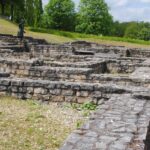 the 2nd century CE, the garrison held over 1,000 soldiers. Ala II Flavia, as it appears in the records, had almost twice that number of horses. The Raetian Limes were only occupied from 105 to 264, a mere 160 years compared to the 340 years of occupation along Hadrian’s Wall. However, the Upper Danube area was not heavily populated, and traces of plowing indicate it was farmland. The museum is outstanding, with many artifacts and information about the Roman period near where we live. As with many Roman sites in the area, there is evidence the Celts were there first. However, there is little evidence of them being conquered. Many Celtic towns, such as the Oppidum in Manching, were abandoned by this time, the people having migrated west or, in some areas, amalgamated into Roman culture.
the 2nd century CE, the garrison held over 1,000 soldiers. Ala II Flavia, as it appears in the records, had almost twice that number of horses. The Raetian Limes were only occupied from 105 to 264, a mere 160 years compared to the 340 years of occupation along Hadrian’s Wall. However, the Upper Danube area was not heavily populated, and traces of plowing indicate it was farmland. The museum is outstanding, with many artifacts and information about the Roman period near where we live. As with many Roman sites in the area, there is evidence the Celts were there first. However, there is little evidence of them being conquered. Many Celtic towns, such as the Oppidum in Manching, were abandoned by this time, the people having migrated west or, in some areas, amalgamated into Roman culture.
It was a fascinating weekend. But work on Monday forced us back into our time machine, my Mini Cooper S, to return to the present and home.
If you could time travel, where would you go? Would you go into the past, like me? Or see what secrets the future offers?
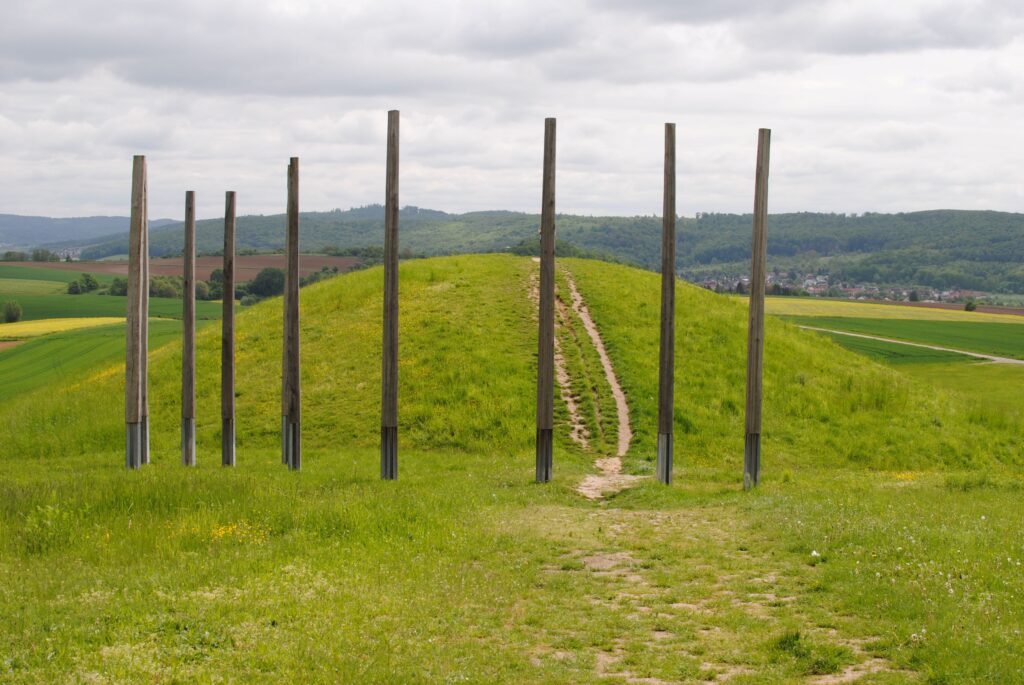
I love to be able to see the transition between ages, going from the neolithic to the bronze to the iron. To see how someone determined what things to put in the fire to make bronze or iron or steel.
Those are things I enjoy, too. I often wonder who thought of so many things.